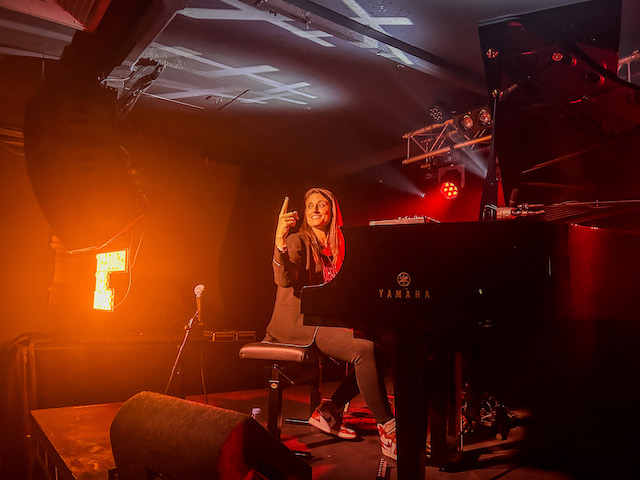Three years after Through the Noise’s first experimental “noisenight” at the Hoxton Underbelly, they are expanding into an international organisation with concerts scheduled for Paris and Brussels this season. Their drive to bring world-class musicians to grassroots venues continues to attract some of classical music’s most galvanising talents; Pavel Kolesnikov, Sheku Kanneh-Mason and classical guitarist Alexandra Whittingham remain among their regular performers.
This week they celebrated a double first – the first time American composer and pianist Natalie Tenenbaum has played in the UK, and the first time they’ve had two concerts simultaneously in different cities. While Tenenbaum dazzled the audience in Hackney with everything from Debussy to Michael Jackson, Georgian pianist Mariam Batsashvili was performing Bach, Haydn and Liszt in Leeds.
Tenenbaum, a Juilliard graduate, has made her name through performing cross-disciplinary works that include classical music, improvisational jazz, electronic music and vocals. Yet while her experimentalism makes her distinctive as a musician, it’s her muscular, fluid technique that defines her as she delivers hailstorms of notes with a clarity and resonance that reinvent each piece she’s playing.
One of the most powerful pieces of the set was her gently improvisatory take on Bach’s Chromatic Fantasy in D minor, which rang out with such freshness and originality it sounded – counterintuitively – like the most subversive piece of the evening. Where so often it’s Bach’s mathematical brilliance that beguiles, here the sense was of an eruption of musical ideas that were deployed with a fierceness and vigour that had the whole nightclub rapt.
The set had begun with Interlude and Prologue – original electric compositions from her recent album Standard Repertoire, that began with a ripples of synthetic sound overlaid with a hallucinogenic haze of vocals. A series of crystal-clear runs on the piano were succeeded by more synthetic vocals before a simple lilting accompaniment in the left hand underscored a hypnotically plangent, almost Satiesque melody in the right hand.
One of the most virtuosic moments of the evening came when she played Hungarian pianist György Cziffra’s jaw-droppingly difficult whole-octave arrangement of Rimsky Korsakov’s Flight of the Bumblebee, accompanied by an electronic beat. A couple in front of me couldn’t stop themselves dancing as Tenenbaum’s hands appeared to move as fast as a bumblebee’s wings up and down the keyboard.
 She then slowed the momentum with another of her own compositions, Epilogue, which began with fragments of laughter and the sounds of smashing glass before the sound of rippling water filled the club. The starkly simple vocals, “At the end of each day, what was it for?” were ornamented by a gently giddy jazz exposition in the right hand.
She then slowed the momentum with another of her own compositions, Epilogue, which began with fragments of laughter and the sounds of smashing glass before the sound of rippling water filled the club. The starkly simple vocals, “At the end of each day, what was it for?” were ornamented by a gently giddy jazz exposition in the right hand.
Maybe this was to give the other hand a rest before one of the piano repertoire’s most famous workouts for the left hand, Chopin’s Revolutionary Study. By this point it shouldn’t have been a surprise that Tenenbaum was one of the few pianists who had decided that it needed more notes, interspersing the Chopin with her own improvisations. From a classical stance, her performance was immaculate – once more, an added electronic beat had some of the audience members dancing along. Yet here the original Chopin sounded stronger than the improvisation that embellished it – though you still admired her for trying.
A highlight came with her take on Debussy’s Reflets Dans L’Eau. Though Tenenbaum joked she couldn’t pronounce it in French, when she performed it felt like a natural fit for her shimmering, fluid style. The impressionistic textures enveloped the audience like gauze right up till the more stately, sonorous finish.
The Stride Etude – her own composition – pitched us into the tearaway brilliance of a jazz piece that sounded like the soundtrack to a black and white comedy movie. This took us into the last part of the set which was dominated by two medleys. MJ5 was a scintillating mashup of Michael Jackson numbers, starting with a nod to Smooth Criminal before riffing on Thriller (which included banging the piano lid as a drum beat), Bad, Human Nature, Beat It and Black or White. As crazy as it was energising, it was a fantastic, vivid response to the originals.
Following a brief detour via Chris Isaak’s Wicked Game – which Tenenbaum also sang – she rounded off the set with her medley of Bernstein’s Westside Story. Here the full theatricality of her piano playing came through as she shifted between the visceral thrill of the gang numbers and the plaintive opulence of the love songs. It was a wonderful, exuberant end to an evening that deftly balanced the jaw dropping with the reflective. Hopefully Tenenbaum will be encouraged enough by her reception to become another Through the Noise regular.















Add comment